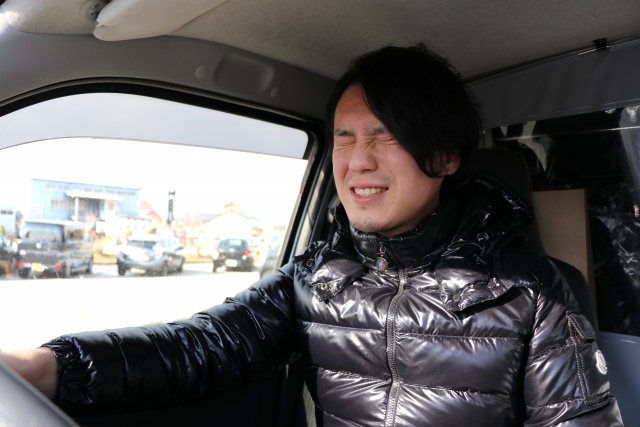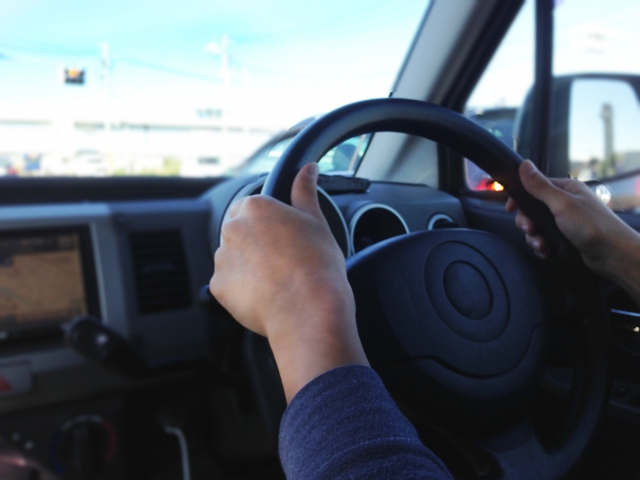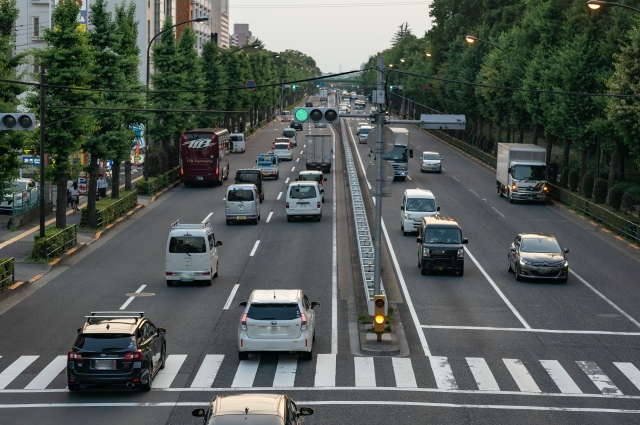まだまだ運転に慣れてない方は、ハンドルを握るたびにいつも「運転怖いな…」と感じていませんか?
運転が怖いと思う人の理由は大きく4つに集約されます。
① 苦手な操作・シーンがある
② 攻略の難しい都心の道
③ 交通ルールがあいまい
④ 事故を起こすこと・それに対する過失
つまり「苦手な運転操作・道路状況の克服」と「乗車前の万全な備え」を徹底することでその恐怖心は払拭することができます。
ここでは具体的に運転が怖いと思う理由とそれらの解決策を丁寧に解説します。
記事の内容を徹底すれば、必ずあなたの恐怖心を取り除くことができます。ぜひ実践してドライブを楽しみましょう。
1.運転が怖いと感じる方へ

ここで運転が怖い人のリアルな声を紹介します。
【その1】
「車の運転にて、車線変更が苦手です。後続車との距離感が掴めなかったりが主な理由かと思います。」
【その2】
「大抵都心の道というのは郊外と違って、車が後ろからひっきりなしにやってくる。」
「一方通行がとにかく多い。」
【その3】
「朝と夕方の時間指定で右折出来ない交差点を右折してしまい切符を切られました!」
【その4】
「このあいだ事故を起こしてしまいそれ以来車の運転が怖いです。」
他にもさまざま意見がありますが、冒頭でも述べたように恐怖心はおもに次の4つの要因から生まれてきます。
① 苦手な操作・シーンがある
② 攻略の難しい都心の道
③ 交通ルールがあいまい
④ 事故を起こすこと・それに対する責任
これらの要因を解決するために以下のポイントを押さえる必要があります
①苦手な操作・シーンがある
②攻略の難しい都心の道
→「苦手分野を把握」
③交通ルールがあいまい
④事故を起こすこと・それに対する責任
→「乗車前の万全な備え」
次の項目から具体的にみていきましょう。
2.初心者が最も苦手にしがちな運転操作のコツ

初心者が苦手にしがちな「車線変更」と「駐車」を取り上げます。
車線変更
車線変更は大通りなどを走る上で不可欠です。再度プロセスを確認しましょう。
①車線変更前、車のスピードを落とさないようにする。
車線変更前にスピードを落としてしまうと変更先の車線を走る車が追い付いてしまい、タイミングを失ってしまいます。
②後続車をミラーと目視で確認する。
実際に走行すると目視で後方全てを確認する余裕はあまりありません。走行前にミラーを調節してあらかじめ視野を確認しましょう。目視はミラーの死角を補うイメージです。
③早めにウインカーを出す
後続車との距離を十分に取れたら早めに合図しましょう。ウインカーに気づけば自分が運転する車のスペースをしっかりと確保してくれます。
④前の車に合わせて車線変更する
後ろの車に合わせてしまうと、スピードが落ちてしまい大変危険です。前の車にくっつくイメージで走行してください。ただし寄りすぎに注意!
駐車
なかなか枠に収まらず何度も切り返し・・・という経験はありませんか?一度車を動かしたら永久に走りっぱなしということはありません。必ず駐車します。一発で駐車するために以下のポイントを押さえてください。
①駐車したい場所に車を寄せる!
まずは車を切り返すスペースを確保することが必須です。
②基本は左隣の車を基準に駐車する
駐車する際は左の枠線の先端と左後輪を合わせるところからスタートします。右隣の車に合わせると、自分の車との距離感がうまくつかめず追突する恐れがあるからです。
③ハンドル操作とバック操作を同時に行わない
慣れないうちはバックしながらハンドルを切るとタイヤの位置がつかめず、なかなか枠に収まりません。ハンドルを十分に切る→バック操作を交互に繰り返し落ち着いて駐車しましょう。
3.都心にありがちな道路状況で気をつけること

都心は交通量も人も多く、郊外にはない危険な箇所がたくさんあります。
交通量の多い道
「広い視野を持つ」ことや「死角からの飛び出しに気を付ける」ことは大前提ですが、特に交通量の多い道では以下のことに注意が必要です。
①右左折した先の道に注意を配る
交差点ではまず歩行者と対向車の流れに気をつけますが、曲がった先の道が渋滞している場合があります。もし交差点で立ち往生してしまったら進行妨害になってしまいます。進行先の状況をよく見て、必要な場合その場にとどまりましょう。
②車幅の感覚をつかむ
特に狭い道を走行するとき、自分の車の車幅を理解することが必要です。基本的にボンネットの中心が左タイヤ、アクセルの延長線上が右タイヤの目印になります。ただし感覚のみでは重大な事故を招きかねないので、目視や徐行も忘れないでください。
③標識の見落としに注意
都会の道は「一方通行」や「進入禁止」の標識がたくさんあります。運転に集中しすぎるあまり、標識の指示を見落とさないようにしましょう。
都市高速の走行
都市高速は一般的な高速道路と違って、大都市の狭い空間を縫うようにして走らせています。そのため急カーブやトンネル、分岐点など特有の難関ポイントがあり、ドライバーにとって鬼門の一つになっています。いくつかポイントを見てみましょう。
①走行前に・・・
複雑な構造ですが、道路上に設置された案内板や標識はザックリとしています。そのためまだ慣れていない人にとって案内板を頼りに走行することはかなり難しいでしょう。乗車前の経路計画はマストです。
例えば東京都心を走る首都高速道路ではドライバーズサイトが開設されており、ドライバーに必要な交通情報やルート検索を提供しています。活用してみましょう。
首都高速道路ドライバーズサイト:http://www.shutoko.jp/
②走行中は・・・
走行中に気を付けるべきポイントは以下の3つです。
急カーブ/車線変更/合流
「急カーブ」は都市高速を走ると必ず遭遇します。一般道とは違いスピードが出ているので、直線区間での十分な減速が必要になります。曲がるときは必ずブレーキを使って速度を調節してください。また事故多発地点のカーブは道路が赤く舗装されている場合があります。このような急カーブに差し掛かった際には気を引き締めて運転しましょう。
「車線変更」のポイントは上記した記事を参考にしてください。特に首都高速には多くの分岐点が点在しています。車線変更は分岐に差し掛かる直前ではなく余裕をもって済ませておきましょう。
最後に「合流」です。通常、高速道路の合流車線は左側に設置されていますが、首都高速は右側からの合流もあります。ただ意識すべきポイントは同じなので決して怖がる必要はありません。
一般的に合流のポイントは「ウインカーを早く出し、遅く戻す」こと、そして「ウインカーを出したら一気に加速すること」です。実は車線変更をするコツと似ているので、一般道で車線変更に慣れた人にとって合流はすぐにマスターできる事です。しかし、都市高速は合流車線が短いので、一気に加速しないと後続車と事故を起こしてしまうこともあります。そのため都市高速の合流で注意したいことは特に「前の車を見る」こと、「一気に加速すること」になります。
4.まさかの事態にパニックにならないために

安心して運転に望むために乗車前にチェックすべきこと
最低限覚えるべき標識
学科の授業で習った標識。しばらく運転しないでいるとその意味を忘れてしまうことはありがちな話です。理想は学科教本を引っ張り出して覚え直すことですが、時間も労力も使うので最低限次の標識を押さえておきましょう。
①「止まれ」

この標識があるときは停止線で一時停止をしなければなりません。最も基本的な標識ですが、暗かったりすると案外見落としてしまう人がいます。ちなみに「一時停止」とは「車が完全に静止した状態」のことです。
②指定方向外進入禁止

矢印の方向のみ進行することができます。もし見落として指定外の道に進むと、違反をとられたり重大な事故を起こしたりしてしまいます。必ず守ってください。
③一方通行・進入禁止


上でも述べたように都心の道は一方通行だらけです。進入禁止は一方通行の出口によく設置されていますが、もし知らずに進入してしまうと逆走になり正面衝突を起こしてしまいます。必ずセットで覚えましょう。
事故の処罰と対策法について
国内では悲惨な交通事故を無くすために様々な取り組みがなされていますが、残念ながら0になることはありません。ここでは主に「自動車対歩行者」の事故の処罰と対策について解説します。
歩行者との事故が多発するシチュエーションは次の3つです。
・横断歩道
・駐車場内
・子供の飛び出し
そしてもう一つ押さえたいポイントは「過失割合」です。過失割合とは事故の当事者がどちらがどれだけ責任を負うのかを表したものです。
あくまで一例ですが、以下のケースを紹介します
ケース1:横断歩道
直進車と横断歩道(信号のある・ない関わらず)を渡っていた人がぶつかったケースなどでは、基本的に歩行者の過失割合は0(自動車の過失割合が100)となります。歩行者が信号を無視、あるいは横断歩道外を歩行した場合、歩行者の過失割合が上昇します。(例えば車両信号が青だった場合、歩行者の過失割合は70%まで上がります)しかしいずれにせよ自動車の過失割合が0になることはありません。
ケース2:駐車場内
駐車スペースに人がいて事故を起こした場合、自動車の過失割合は90になります。また場内を走行中に歩行者をはねた場合も同じ割合です。
ケース3:子供の飛び出し
保護者の不注意により歩行者の過失をある程度求めることは可能です。しかし、自動車側の過失割合が0になることはほぼありません。
事故を起こさないために…
1.歩行者保護を徹底する
自動車は強者、歩行者は弱者であることを忘れてはいけません。ケースで示した通り、自動車の過失は0になることはまずありません。横断歩道(特に信号のないところ)付近で歩行者を見かけたら細心の注意を払い、いつでも止まれるようにしましょう。駐車場内は徐行することを忘れずに。
2.歩行者と自動車の感覚は1.5メートル以上空ける
双方が安全に通行するための間隔です。(これが確保できない道では徐行が必須です。)しっかりと覚えておきましょう。
5.まとめ
ペーパードライバー講習も活用しましょう
久しくハンドルを握っていない方向けに、ペーパードライバー講習を実施している教習所もあります。(時期によって実施していないこともあるので必ず問い合わせてください)
「東京のペーパードライバー講習ならここ!おすすめスクール9選」
https://www.paperdriver-navi.com
このサイトでは都内のおススメスクールやペーパードライバーに関する情報を紹介しています。参考にしてください。
怖いという気持ちは大切!
実は「怖い」と思うことで、事故起こさないよう慎重な運転が出来るのです。逆に慣れてきた頃には注意してください。多くのドライバーは運転に慣れ始めたころに事故や違反を起こしています。初心忘るべからず!ですね。
最後に
「運転が楽しい」と思い始めるには何度も運転をして難しい技術や状況判断を体得する必要があります。記事でのべたポイントのうち自分に足りない!と思ったところをしっかりと抑え、積極的に運転にチャレンジしましょう。間違いなくドライブが好きになります。







